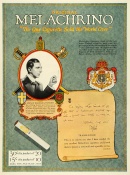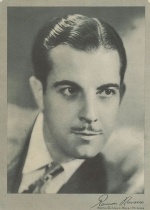Difference between revisions of "Chapter 19"
(→Page 138) |
|||
| Line 56: | Line 56: | ||
'''"Things been a little slow, Gingersnap...?"'''<br /> | '''"Things been a little slow, Gingersnap...?"'''<br /> | ||
"Gingersnap" as slang for a girl appears in the 1910s–1930s, meaning a lively, cute, spirited, slightly cheeky young woman. It’s affectionate, playful, and a little flirtatious but never insulting. | "Gingersnap" as slang for a girl appears in the 1910s–1930s, meaning a lively, cute, spirited, slightly cheeky young woman. It’s affectionate, playful, and a little flirtatious but never insulting. | ||
| + | |||
| + | '''"Ramon Novarro could learn makeup tips"'''<br /> | ||
| + | [[image:Ramon-Novarro-1930s.jpg|thumb|150px|'''Ramón Novarro, 1930s'''|left]]In the 1930s, Ramon Novarro transitioned from a leading silent film star to navigating the challenges of sound films, a period that saw both success and the beginning of his career's decline. He starred in the popular Greta Garbo film ''Mata Hari'' (1931) but found his leading roles became scarce as he was often cast in exotic "Latin" roles. | ||
Revision as of 13:16, 9 November 2025
Page 132
"ocean liner Stupendica"The S.S. Stupendica makes an appearance in Pynchon's Against the Day, being the liner the Zombini family takes to Europe for a tour. Discussion
"smoking a Melachrino in a jade holder"Melachrino cigarettes — "the aristocratic Egyptian cigarette" — were an Egyptian brand popular from the late 19th century through mid-20th century. In its advertising it emphasized Orientalism (romanticizing "the East"), worldliness and sophistication, and high-class leisure (opera, hotels, international travel).
Page 133
junior purser
This would be an assistant to the purser on an ocean liner who was the ship’s chief administrative and financial officer — essentially the head of the ship’s hotel, passenger, and business operations, while the captain handled navigation and command.
Page 134
"furtive Ronald Colman faces"
The on-screen characters played by English actor Ronald Colman (1891-1958) could be described as quiet, elegant, and inward. He projected cultivated restraint: a man of gentle intelligence, lightly ironic charm, and emotion held just beneath the surface. Even in dramatic moments, he remained composed, conveying depth through voice, posture, and a faint, private sadness rather than overt display.
"current husband Porfirio"
Perhaps the name alludes to Porfirio Diaz, the dictator of Mexico from 1876 until his overthrow in 1911. Over time, his "Spanish-sounding" name became shorthand for a romantic, flamboyant, suave, and slightly ridiculous Latin lover. During the post–Rudolph Valentino "Latin Lover" craze, and the name "Porfirio" was often deployed by comic writers, vaudeville routines, dance-hall jokes, and humor columns.
autogyro
an early type of rotary-wing aircraft invented in the 1920s by the Spanish engineer Juan de la Cierva. It looks a bit like a small airplane with a free-spinning rotor on top.
"One of those rigs [...] I keep seeing in Popular Mechanics
January 1929, Popular Mechanics ran one of the first U.S. popular press features on Juan de la Cierva’s autogyro, explaining the principle of autorotation and showing the early Cierva models being tested in Europe. It continued to feature the planes throughout the years.
Gaudeamus igitur
The opening line of a medieval student drinking song that became the traditional university graduation song across Europe. The full title is usually Gaudeamus Igitur, Juvenes Dum Sumus ("Let us rejoice, therefore, while we are young.")
Page 135
'Sticky—Toffee—Pud-ding?'
Sticky Toffee Pudding is a classic British dessert: a warm, moist date cake soaked in a buttery toffee sauce, usually served with vanilla ice cream, custard, or clotted cream. It’s rich, comforting, and not difficult to make. A dessert with this name wasn't offered in America of the 1930s and was only beginning to be offered in the U.K.
"a chop house called St. Hubert's..."
St. Hubert’s Chop House was a well-known Chicago Loop restaurant in the 1920s and 1930s, located at 22 West Randolph Street, just west of State Street, in what was then the very center of the theater-and-hotel district. It was part of the old-style "chop house" tradition: dark wood, leather booths, heavy meals, and a clientele of salesmen, newspapermen, brokers, and political fixers.
"your Mr. Dawes, savior of the German economy"
Refers to Charles G. Dawes (1865–1951), Chicago banker, brigadier general in WWI, later Vice President under Coolidge, and, most importantly in this context, the architect of the 1924 Dawes Plan, devised to rescue the collapsed German economy after World War I, for which he received the 1925 Nobel Peace Prize.
Union League Club
The Union League Club of Chicago, founded in 1879, is and was one of the city’s most historically significant private civic clubs, a pillar of the Reform Republican / business-civic elite since the late 19th century. Members historically included bank presidents,federal judges, railroad and utilities executives, university trustees, senior lawyers, philanthropists, military officers. This is the world of Charles G. Dawes
"Republicans and gangsters? How can such a thing be?"...
Heh heh.
Page 136
"Mr. Guzik did happen to mention his role in helping with [...] the Dawes Plan"Both Guzik and Dawes operated in the same Chicago power structure, but at different tiers — Dawes in high finance, international stabilization, banker-politician, and Guzik in street-level political influence, bribery networks, gangster patronage. But both relied on the same machine: Chicago aldermanic control; police patronage system; ward organizations; and Commercial corridors tied to city contracting. The Dawes Plan pumped foreign capital through Chicago banks, expanding real estate mortgage credit, commercial construction, street and transit development contracts, and public utility finance. Guzik, meanwhile, controlled the political gatekeepers who steered permits, inspections, and union access on those same projects.
"Alf expects a "Great Simplification" quite soon..."
The phrase "Great Simplification" in the 1930s refers to the widespread design and cultural shift away from ornament, fuss, and excess toward clean lines, functional forms, and visual clarity, in industrial design, architecture, advertising / product styling, and interior and graphic design. The term appears in trade journals, design lectures, and popular magazines (including Fortune, Architectural Forum, and House & Garden) beginning around 1930–1932, especially after the stock market crash, when extravagance looked not only old-fashioned but socially tone-deaf.
Page 137
"Now, none of that Pip Emma, you damned flirt,"
"Pip" is a diminuitive of "Philippa," so perhaps Philippa's middle name is Emma?
Page 138
"Things been a little slow, Gingersnap...?"
"Gingersnap" as slang for a girl appears in the 1910s–1930s, meaning a lively, cute, spirited, slightly cheeky young woman. It’s affectionate, playful, and a little flirtatious but never insulting.
"Ramon Novarro could learn makeup tips"

